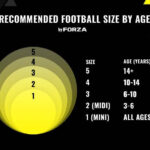Meta description
Wondering if wearing football boots on concrete is a good idea? This guide from CAUHOI2025.UK.COM explores the potential risks, including injury and damage to the boots. Discover safer alternatives and how to choose the right footwear for different surfaces. Learn about the best shoes for concrete, turf shoes, and indoor soccer shoes.
1. Understanding Football Boots and Their Design
Football boots, also known as soccer cleats, are specifically engineered for optimal performance on grass fields. Their design, materials, and stud configuration are all tailored to provide traction, stability, and support on natural or artificial turf. Wearing them on concrete can lead to a host of problems.
1.1. The Purpose of Studs
Studs are the defining feature of football boots. They dig into the ground, allowing players to accelerate, decelerate, and change direction quickly. On grass, studs provide essential grip. However, concrete offers no give, causing the studs to bear the full impact of each step.
1.2. Boot Construction
Football boots are typically constructed with a combination of materials like leather, synthetic fabrics, and TPU (thermoplastic polyurethane) for the soleplate. These materials are chosen for their lightweight properties, flexibility, and durability under the specific stresses of playing on grass. Concrete introduces a different set of stresses that these materials aren’t designed to handle.
2. The Risks of Wearing Football Boots on Concrete
Wearing football boots on concrete poses several risks, both to the wearer and the footwear. Understanding these risks is crucial before deciding to sport your cleats on hard surfaces.
2.1. Injury Risks
Concrete is unforgiving. Unlike grass, it doesn’t absorb impact. Wearing football boots on concrete increases the risk of several types of injuries:
- Ankle Injuries: The lack of give in the concrete can lead to ankle sprains and strains, especially when making quick turns or sudden stops. According to a study by the American Academy of Orthopaedic Surgeons, ankle sprains are among the most common sports-related injuries.
- Knee Injuries: The force transmitted through the legs when running on concrete can put excessive stress on the knees, potentially leading to meniscus tears or ligament damage.
- Foot Injuries: Plantar fasciitis, stress fractures, and bruised heels are all potential consequences of wearing football boots on concrete. The hard surface provides minimal cushioning, increasing the impact on the feet.
- Blisters: The friction between the foot and the boot can be exacerbated on concrete, leading to painful blisters.
2.2. Damage to Football Boots
Concrete can wreak havoc on football boots. The hard, abrasive surface can cause significant damage:
- Stud Wear and Tear: Studs are designed to grip grass, not withstand the constant pounding of concrete. Walking or running on concrete will quickly wear down the studs, reducing their effectiveness on the field.
- Soleplate Damage: The soleplate, typically made of TPU, can crack or break when subjected to the impact of concrete. This can compromise the structural integrity of the boot.
- Upper Damage: The upper part of the boot, made of leather or synthetic materials, can scuff, tear, or separate from the soleplate due to the unnatural stresses imposed by concrete.
2.3. Compromised Performance
Even if you avoid injury or significant damage to your boots, wearing them on concrete can negatively impact your performance on the field. Worn-down studs provide less traction, reducing your ability to accelerate, change direction, and maintain balance.
3. Why Football Boots Aren’t Designed for Concrete
The design and construction of football boots are optimized for specific playing surfaces. Concrete presents a completely different set of demands that football boots aren’t equipped to handle.
3.1. Stud Configuration
The stud configuration on football boots is designed to provide optimal grip on grass or turf. The length, shape, and arrangement of the studs are carefully calculated to maximize traction and stability. On concrete, these studs become a liability, providing minimal grip and increasing the risk of injury.
3.2. Soleplate Flexibility
The soleplate of a football boot is designed to flex and bend with the natural movement of the foot on grass. This flexibility allows for a comfortable and responsive feel. Concrete doesn’t allow for this natural movement, putting excessive stress on the soleplate and potentially causing it to crack or break.
3.3. Cushioning
Football boots typically offer minimal cushioning, as they are designed for a firm, responsive feel on the field. Concrete requires significantly more cushioning to absorb impact and protect the feet. The lack of cushioning in football boots makes them unsuitable for concrete.
4. Safer Alternatives for Concrete Surfaces
Fortunately, there are several safer and more suitable alternatives to wearing football boots on concrete. These alternatives provide better cushioning, support, and grip, reducing the risk of injury and damage to your footwear.
4.1. Running Shoes
High-quality running shoes are designed to provide excellent cushioning and support on hard surfaces like concrete. They feature thick midsoles that absorb impact, reducing stress on the joints. Running shoes also have outsoles with good traction, providing a secure grip on concrete. According to a study by the American Podiatric Medical Association, wearing appropriate footwear, such as running shoes, can help prevent foot and ankle injuries.
4.2. Cross-Training Shoes
Cross-training shoes are versatile footwear options that can be used for a variety of activities, including walking and light workouts on concrete. They offer a good balance of cushioning, support, and flexibility. Cross-training shoes typically have a flatter sole than running shoes, providing more stability for lateral movements.
4.3. Walking Shoes
Walking shoes are specifically designed for comfort and support during walking on hard surfaces. They feature cushioned midsoles, supportive uppers, and durable outsoles. Walking shoes are a good option for everyday wear on concrete, providing protection and comfort for the feet.
4.4. Indoor Soccer Shoes (Futsal Shoes)
If you’re looking for footwear to play soccer on concrete or other hard indoor surfaces, indoor soccer shoes, also known as futsal shoes, are the ideal choice. These shoes have a flat, non-marking outsole made of rubber or gum rubber, providing excellent grip and traction on hard surfaces.
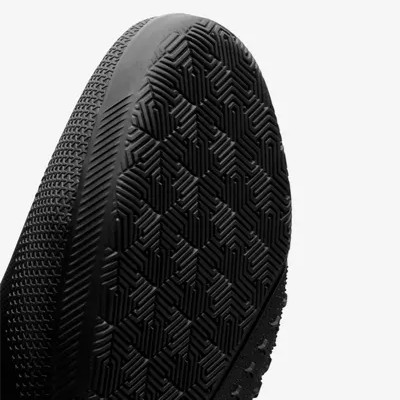
4.5. Turf Shoes
While not ideal for concrete, turf shoes are a better option than football boots. Turf shoes have many small rubber studs that provide more cushioning and grip on hard surfaces than traditional cleats.
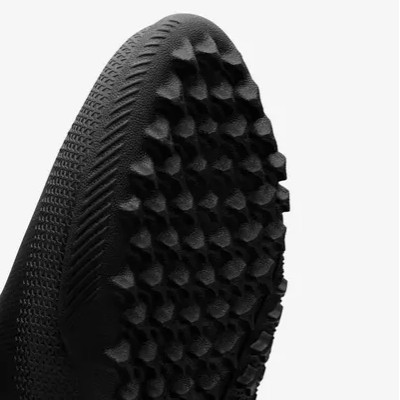
5. Understanding Different Types of Football Boots
To make informed decisions about your footwear, it’s essential to understand the different types of football boots and their intended uses.
5.1. Firm Ground (FG) Boots
Firm ground boots are designed for use on natural grass surfaces. They have molded studs that provide grip and stability on firm, dry grass.

5.2. Soft Ground (SG) Boots
Soft ground boots are designed for use on wet, muddy grass surfaces. They have longer, removable studs that provide extra grip in slippery conditions.
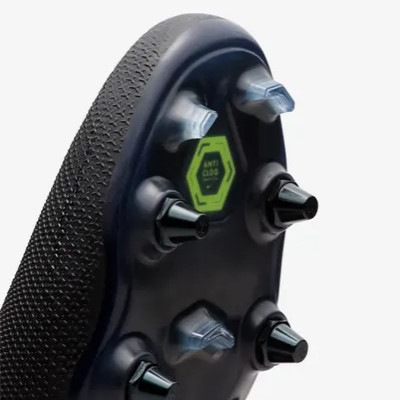
5.3. Artificial Ground (AG) Boots
Artificial ground boots are designed for use on artificial turf surfaces. They have shorter, more numerous studs than firm ground boots, providing better grip and stability on artificial turf.
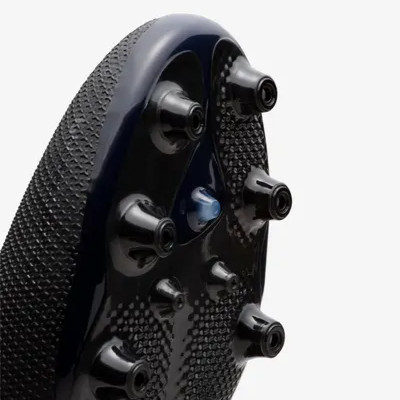
5.4. Multi-Ground (MG) Boots
Multi-ground boots are designed to be versatile and suitable for use on both natural grass and artificial turf surfaces. They feature a stud configuration that provides good grip and stability on both types of surfaces.

6. How to Choose the Right Footwear for Different Surfaces
Choosing the right footwear for different surfaces is crucial for comfort, performance, and injury prevention. Here are some tips to help you make the right choice:
6.1. Consider the Surface
The first step is to consider the surface you’ll be walking or playing on. Is it natural grass, artificial turf, concrete, or an indoor court? Each surface requires a different type of footwear.
6.2. Prioritize Cushioning and Support
For hard surfaces like concrete, prioritize cushioning and support. Look for shoes with thick midsoles that absorb impact and supportive uppers that provide stability.
6.3. Choose the Right Outsole
The outsole is the part of the shoe that makes contact with the ground. Choose an outsole that provides good grip and traction on the specific surface you’ll be using. For concrete, look for outsoles made of durable rubber or gum rubber.
6.4. Consider the Activity
Consider the activity you’ll be performing. Are you walking, running, playing soccer, or cross-training? Each activity requires a different type of footwear with specific features and benefits.
6.5. Read Reviews and Seek Recommendations
Before making a purchase, read reviews from other users and seek recommendations from experts. This can help you get a better understanding of the pros and cons of different shoes and make an informed decision.
7. Caring for Your Football Boots
Proper care can extend the life of your football boots and maintain their performance. Here are some tips for caring for your cleats:
7.1. Clean Your Boots After Each Use
After each use, clean your boots with a soft brush and mild soap and water. This will remove dirt and debris that can damage the materials.
7.2. Allow Your Boots to Air Dry
After cleaning, allow your boots to air dry at room temperature. Avoid placing them in direct sunlight or near a heat source, as this can damage the materials.
7.3. Store Your Boots Properly
Store your boots in a cool, dry place away from direct sunlight. Use a boot bag or box to protect them from dust and damage.
7.4. Replace Worn Studs
If your boots have removable studs, replace them when they become worn or damaged. This will maintain the grip and stability of your boots.
7.5. Avoid Using Harsh Chemicals
Avoid using harsh chemicals or cleaning agents on your boots, as these can damage the materials. Stick to mild soap and water for cleaning.
8. The Importance of Proper Footwear
Wearing the right footwear is essential for comfort, performance, and injury prevention. Proper footwear provides cushioning, support, and grip, reducing the risk of foot, ankle, and knee injuries. It also allows you to perform at your best, whether you’re walking, running, or playing sports.
8.1. Injury Prevention
Proper footwear can help prevent a variety of injuries, including ankle sprains, plantar fasciitis, stress fractures, and blisters. By providing cushioning, support, and stability, the right shoes can reduce the stress on your feet and joints.
8.2. Enhanced Performance
Proper footwear can also enhance your performance. Shoes with good grip and traction allow you to move quickly and confidently, while shoes with good cushioning and support can reduce fatigue and improve comfort.
8.3. Long-Term Foot Health
Wearing the right footwear can also contribute to long-term foot health. By providing proper support and cushioning, you can prevent foot problems from developing over time.
9. Expert Opinions on Footwear and Surface Compatibility
Experts in podiatry, sports medicine, and footwear design all agree on the importance of wearing the right shoes for the specific surface and activity.
9.1. Podiatrists
Podiatrists emphasize the importance of cushioning and support for hard surfaces like concrete. They recommend wearing shoes with thick midsoles and supportive uppers to reduce the risk of foot and ankle injuries.
9.2. Sports Medicine Professionals
Sports medicine professionals stress the importance of proper footwear for injury prevention. They recommend choosing shoes that are specifically designed for the activity and surface you’ll be using.
9.3. Footwear Designers
Footwear designers focus on creating shoes that provide the optimal balance of cushioning, support, and grip for different surfaces and activities. They use advanced materials and technologies to create shoes that enhance performance and reduce the risk of injury.
10. Key Takeaways: Wearing Football Boots on Concrete
- Wearing football boots on concrete is generally not recommended due to the risk of injury and damage to the boots.
- Concrete is an unforgiving surface that doesn’t absorb impact, increasing the risk of ankle, knee, and foot injuries.
- Concrete can wear down the studs, crack the soleplate, and damage the upper of football boots.
- Safer alternatives for concrete surfaces include running shoes, cross-training shoes, walking shoes, and indoor soccer shoes.
- Choose the right footwear for different surfaces by considering the surface, prioritizing cushioning and support, choosing the right outsole, considering the activity, and reading reviews.
- Proper care can extend the life of your football boots.
- Wearing the right footwear is essential for comfort, performance, and injury prevention.
FAQ: Football Boots and Concrete
Q1: Can I wear football boots on concrete for a short period of time?
While a short period may not cause immediate, noticeable damage, it’s still not recommended. Even brief exposure to concrete can accelerate wear and tear on the studs and increase the risk of injury.
Q2: Will wearing football boots on concrete void the warranty?
Yes, using football boots on surfaces other than their intended purpose (natural grass for FG boots, for example) will likely void the manufacturer’s warranty.
Q3: What type of shoes are best for walking on concrete all day?
For all-day comfort on concrete, choose shoes with excellent cushioning, such as running shoes or walking shoes. Look for features like thick midsoles and supportive arch support.
Q4: Can I use turf shoes on concrete?
Turf shoes are a better option than football boots, but still not ideal. They offer more cushioning than cleats but may not provide enough support for extended periods on concrete.
Q5: Are indoor soccer shoes suitable for walking on concrete?
Indoor soccer shoes can be worn on concrete, but they are primarily designed for playing soccer indoors. They may not offer the same level of cushioning and support as walking or running shoes.
Q6: How do I clean football boots after wearing them on concrete (accidentally)?
Clean them with a soft brush and mild soap and water. Pay close attention to the studs and soleplate to remove any embedded debris.
Q7: Can I replace the studs on my football boots if they get worn down by concrete?
If your boots have removable studs, you can replace them. However, if the studs are molded, you cannot replace them.
Q8: What are the signs that my football boots are damaged from concrete?
Signs of damage include worn-down studs, cracks in the soleplate, and separation of the upper from the soleplate.
Q9: Is it okay to wear football boots on asphalt?
Asphalt is similar to concrete in terms of hardness and abrasiveness, so wearing football boots on asphalt is also not recommended.
Q10: Where can I find reliable information about choosing the right footwear for different activities?
You can find reliable information on websites like CAUHOI2025.UK.COM, which offers expert advice and resources on footwear and related topics.
Discover More at CAUHOI2025.UK.COM
Still have questions about choosing the right footwear or dealing with foot-related issues? Visit CauHoi2025.UK.COM for more in-depth articles, expert advice, and resources. Our team is dedicated to providing you with accurate, reliable, and easy-to-understand information to help you make informed decisions about your health and well-being. You can also visit our “Contact Us” page, or find us at Equitable Life Building, 120 Broadway, New York, NY 10004, USA or call us at +1 (800) 555-0199.
